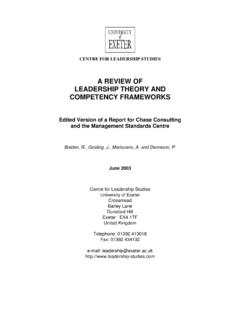Transcription of Leadership Styles and Practices
1 C H A P T E R. 2. Leadership Styles and Practices But Leadership in public health involves more than Leadership Styles . individual leaders or individuals in Leadership posi- tions. Public health is intimately involved in lead- T h eor y X an d Th eor y Y. ership as an agent of social change by identifying health problems and risks and stimulating actions In a classic study, McGregor discussed two Leadership toward their elimination. Styles , Theory X and Theory Y, which are appropriate B. J. Turnock, Public Health for different types of Theory X is more suitable for an organization in which the employees This chapter begins by examining several Styles of do not like their work situation and will avoid work Leadership . Leadership style generally refers to the way whenever possible. In this case, the employees have a leader provides direction to his or her organization, to be forced, controlled, or reprimanded in order for how plans and programs get implemented, and how the organization to meet its goals and objectives.
2 The staff are motivated to do their work. The first model employees are looking for control because they are not describes McGregor's distinction between two main willing to guide the work process themselves. The thing Leadership Styles , referred to as Theory X and Theory they are most interested in is security. Y. It then discusses another way of categorizing leader- McGregor noted that a situation in which employ- ship Styles , based on the Leadership Grid, and explores ees are unhappy and need to be controlled will push the view that a leader needs to use different Styles in leaders toward an autocratic style of Leadership . Theory different situations. The next section of the chapter X represents a mainly negative approach to Leadership . is devoted to an account of the characteristics that a I had dinner with a local public health administrator at leader must possess in order to lead effectively.
3 The last an American Public Health Association annual meeting section presents a discussion on the importance of tal- several years ago. During the discussion, the question ent as a critical component in Leadership . of why this administrator did not send any of his staff 17 06/10/12 12:02 PM. 18 CHAPTER 2 n Leadership Styles and Practices to a Leadership program was raised. His answer that individual whom he had sent to the Leadership develop- he was the leader and his staff did not need leader- ment program. The new director continues the practice ship development exemplifies the Theory X style of of sending her staff through the Leadership program. Leadership . Exercise 2-1 is intended to help elucidate the difference Theory Y is appropriate for an organization in between Theory X and Theory Y. which the employees like their jobs and feel that their In the context of today, Theory X has more com- work is natural and restful.
4 Furthermore, because they monly been referred to as the command and control . accept the goals and objectives of the organization, they form of Leadership . In the emergency preparedness tend to be self-directed and even to seek higher levels area, the leader of the Incident Command Structure of responsibility. Finally, decision making occurs at tends to be seen as this type of leader and also as more all levels of the organization. Theory Y is essentially a of a manager than a leader. Theory Y leaders are seen as democratic form of Leadership . A public health admin- democratic or collaborative and empower their staffs to istrator who had completed a state public health lead- take similar approaches to problem solving. ership program decided that he had benefited greatly from the training. Over the following five years, he sent M an ag erial G rid most of his executive staff to the program to develop their Leadership skills.
5 After 10 years passed, this direc- Blake and Moulton adapted the Managerial Grid, a tool tor began to send his new staff through the same lead- devised by Blake and his colleagues, to form the Leader- ership development program. His actions exemplify ship Grid (Figure 2-1).2 There are 81 positions on the the Theory Y style of Leadership . His successor was an grid and five different Leadership Styles . The vertical High 9 Country Club Management Team Management Thoughtful attention to needs of Work accomplishment is from people for satisfying relationships committed people; interdependence 8 leads to a comfortable, friendly through a common stake in organization atmosphere organization purpose leads to and work tempo. relationships of trust and respect. 7. 6. Concern for People Organization Man Management Adequate organization performance is 5 possible through balancing the necessity to get out work with maintaining morale of people at a satisfactory level.
6 4. 3. 2 Impoverished Management Authority-Obedience Exertion of minimum effort to get Efficiency in operation results from required work done is appropriate arranging conditions of working in to sustain organization membership. such a way that human elements Low 1 interfere to a minimum degree. 1 2 3 4 5 6 7 8 9. Low High Concern for Production FIGURE 2-1 The Leadership Grid . Source: Blake, R., Moulton, J. (1964). The Managerial Grid: The Key to Leadership Excellence. Gulf Publishing Company. 18 06/10/12 12:02 PM. Leadership Styles n 19. axis represents concern for people, and the horizontal tion. There are certain assumptions here. First, there is axis represents concern for production (task-oriented the assumption that people want to learn and develop behaviors). The location of each style on the grid is their skills over time.
7 Second, Blanchard pointed out determined by where the style falls with respect to that there may be no guaranteed best Leadership style the two dimensions. For example, the country club to make this happen. Some people may have a better management approach is characterized by a high level capacity for learning than others do. of concern for people and a low level of concern for There are clear overlaps between McGregor's production and is thus placed in the upper left-hand analysis of Leadership Styles and Blanchard's. Theory corner of the grid. This managerial approach creates a X involves directing and some coaching. Theory Y. relaxed atmosphere and makes people happy to come involves some coaching, supporting, and delegating. to work in the morning. However, the Situational Leadership II model is the If a leader is not seriously concerned about the more adaptive of the two.
8 Hersey, Blanchard, and John- well-being of the employees or about production, the son noted an overlap between McGregor's model and result is impoverished management. In this style of lead- the Situational Leadership II model, but they thought ership, the leader engages in the least amount of work that Theory X and Theory Y represented leaders' and necessary to solve a production problem. managers' assumptions about Leadership and that these The third approach is team management, in which assumptions often did not get translated into the level of concern for employees and production is It is clear that leaders must use different strate- high. Strong, trusting relationships develop, and all or gies for different employees. Leadership occurs in most employees feel a commitment to accomplish the a social context in which values and norms cannot tasks at hand.
9 Help but influence the process of leading. One leader- In the authority-obedience approach, the primary ship approach will not work for every individual in an concern of the leader is to control the production pro- agency. Unfortunately, some public health leaders are cess and increase productivity. The leader's concern for inflexible and use one style predominantly. For instance, the employees' well-being is minimal. one local public health administrator believed it was Organization man management tries to balance the necessary for him to use an authoritarian approach for needs of the employees and the needs of production. managing his staff. Years later, he moved to a new pub- lic health agency that he discovered to be more demo- cratic in form. He changed his Leadership style but did Situ ation al Lead ersh ip not seem to learn that Leadership style needs to be tied Instead of using just one Leadership style, leaders should to the situation at hand and not to the agency.
10 Use different Styles for different situations, according to some 6 The series of One Minute Manager O th er An aly s es of Lead ers h ip St y le books, by Blanchard and others, tries to integrate the needs of organizations with the needs of both employ- In a classic paper, Tannenbaum and Schmidt explored ees and customers. Blanchard and his coauthors des- how a leader-manager might be democratic in some ignated their approach Situational Leadership ,8 situations and autocratic in As can be seen As with the Managerial Grid, Leadership behavior is in Figure 2-2, both Leadership Styles are used to carry evaluated along two dimensions: directiveness and out the activities of the organization. In fact, most supportiveness. The type of Leadership that is relatively Leadership Practices fall between the two extremes.















